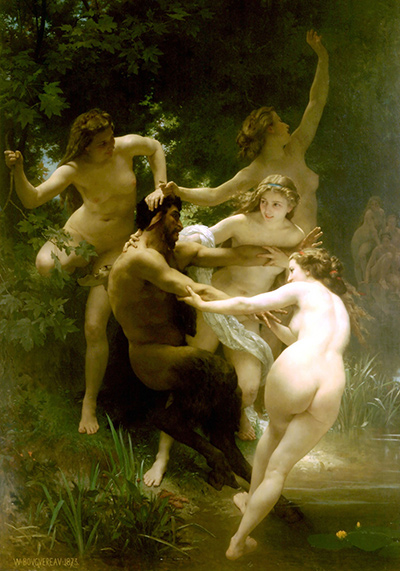Painted in 1873, Nymphs and Satyr is a painting of oil on canvas. A large, almost life like picture, it shows a group of nymphs bathing in a secluded pool.
The picture shows a lustful satyr surprising the nymphs. In the painting, several of the nymphs have withdrawn into the shadows on the right. The other nymphs that remain are braver.
We know this as we see them in the picture trying to dampen the satyr’s lust by dragging him into the pond’s cold water. Even though one of his hooves is already wet, he doesn’t want to go any further.
The first time that Nymphs and Satyr went on display was in Paris in 1873. Given the fascination that American’s had for his works, the painting was purchased by the collector John Wolfe.
He displayed the painting in his mansion alongside other important French academic paintings. It was in 1888 that the painting next changed owners when it went up for sale at auction.
For the next 13 years, the picture went on show in the bar of the Hoffman House Hotel. It was in 1901 that painting next changed owners when it was again sold. This time the painting disappeared from public view being stored in a warehouse.
It appears that the buyer wanted to keep what they saw as its ‘offensive’ content away from the public eye. In 1942 the painting reappeared when by Robert Sterling Clark found it in storage and acquired it. It is now on display at the Clark Art Institute in Williamstown, Massachusetts.
While Bouguereau’s work revealed an idealised world, his paintings had an almost photo-like style. He had studied painting in an academic style. This gave prominence to historical and mythological subjects.
The result was that in creating his many works, Bouguereau made use of traditional methods of working. This included detailed pencil drawings and oil sketches. Often these would be drawings of carefully posed human figures to create poses that linked them together in a beautifully balanced arrangement. His careful approach to his work meant that he was able to show us the female human form in such a way that was both pleasing and accurately rendered.
To many, he typified taste and sophistication, along with respect for tradition. All of this led to Bouguereau’s style being popular with rich art patrons, particularly Americans.
Although at the time, he was very famous however today his works, and his style receives little attention compared with the Impressionist movement that existed at the same time. Bouguereau undertook numerous commissions during his career.
These involved the decoration of private houses, public buildings and churches. While he was very much of the academic style in his paintings on some occasions, he would instead follow an existing group style.
Born in 1825 in La Rochelle, France the artist William-Adolphe Bouguereau was a French academic painter. An accomplished painter who won many awards, Bouguereau was very much a conservative artist and Academic painter.
This led to him producing convincing genre paintings as well as those with mythological themes. It is for such work that he is perhaps best known. His paintings took a fresh look at classical subjects with the emphasis being on the female body. One such painting is Nymphs and Satyr.




